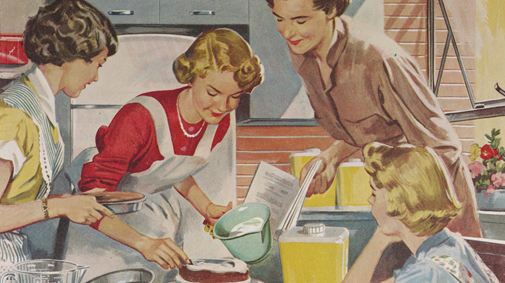
“Tradwives” are having a moment. Amidst the rejection of “lean-in” culture and “girl boss” backlash, a host of popular social media accounts created by and geared toward young women promote the role of traditional wives, or “tradwives.” Now, a proliferation of so-called “aspirational” lifestyle posts romanticize conventional gender roles, marriage, motherhood, domesticity, and financial dependence on men. The “tradwife” hashtag has become so widely used on TikTok and Instagram that the term was added to the Cambridge dictionary last August.
Although framed as a feminine ideal, the tradwife movement is rooted in toxic nostalgia and patriarchal supremacy. But its devastating cultural and political impacts are often discounted because conservative Christian influencers frame the tradwife “lifestyle” as a “personal choice.” Many don’t even claim the label despite actively promoting the movement’s regressive ideologies. In order to prevent the erosion of women’s rights and political escapism, there must be a reckoning with so-called tradwives.
On the surface, popular tradwife influencers, including Hannah Neeleman, Nara Smith, Estee Williams, and the women of #momtok (otherwise known as the stars of the Hulu reality series The Secret Lives of Mormon Wives), appear radically different from one another. For instance, Neeleman is a former Juilliard-trained dancer turned homesteader who dons prairie dresses while milking cows, baking sourdough bread, and homeschooling her children on a Utah farm. Nara Smith, a model, is known for preparing “easy recipes” (like SpaghettiOs from scratch) while wearing elaborate designer dresses. Estee Williams, a former bodybuilder, channels a retro-1950s look and gives advice like, “Keep up your beauty. You and your husband will benefit.” The women of #momtok are “cool moms” who look stylish while busting midriff-baring dance moves. These superficial differences might lead many to believe that the tradwife lifestyle is varied and its advocates are diverse, but the reality is that their underlying message is ultimately the same—they celebrate women’s disempowerment by promoting conservative values.
At its core, the concept of a tradwife is predicated on the acceptance of heteronormative, cis gender relationships that privilege traditional masculinity above all else. In fact, the very prerequisite to be a tradwife is being “chosen” by a man. From a tradwife perspective, a woman’s ultimate value lies in being a wife and mother, which cannot be achieved without male validation. To gain that approval, women must conform to a submissive hyperfeminine ideal. This means focusing on homemaking, childrearing, appeasing their husbands, and maintaining their appearances. As a result, tradwives forfeit opportunities to engage in the larger world and act autonomously. Even if they weren’t preoccupied by chasing trad wife perfection, anything outside the home is considered the purview of their husbands.
Ironically, some of the most successful influencers have found ways to convert social media fame into income through sponsored content and entrepreneurial pursuits of their own (like Neeleman’s Ballerina Farm or Mayci Neeley’s Baby Mama supplements). In other words, the very influencers who proudly profess their commitment to being stay-at-home wives and mothers (rather than “career women”) profit from followers who buy products to emulate the tradwife lifestyle. Even in rare instances when tradwives are their families’ primary breadwinners, the understanding is that their husbands will control and manage their earnings. Despite lucrative brand deals and generating income, tradwife influencers remain financially dependent on men. In essence, they work for them.
As part of #tradwifelife, women are expected to embody a classic femininity that is nonthreatening but also appealing to the male gaze. As such, tradwife influencers and their followers fetishize Eurocentric beauty ideals that are virtually unattainable. This public image manifests in social media posts featuring their extremely fit bodies (often transformed by expensive plastic surgery, augmented with intense exercise and diet), carefully styled hair and makeup, and coordinated outfits—all of which require significant time and money. While some tradwife influencers share allegedly candid “#GRWM” (“get ready with me”) posts, these minimize the cost and effort that goes into their appearance.
Similarly, influencers downplay the realities of childbirth—a central component of the tradwife life—and its physical toll on mothers. For example, when Neeleman chose to compete for the Mrs. World beauty title just two weeks after the unmedicated home birth of her eighth child, she dismissed the possibility of any hardships in preparing for the pageant. Not only does her example set unrealistic expectations for beauty and motherhood, it also tacitly reinforces how events like the Mrs. World beauty pageant focus on women’s bodies and appearances as ways to police and control them.
To be clear, many of the influencers extolling the virtues of being a tradwife can only do so because of their privilege. Generational wealth and family support, along with the monetization of their social media accounts, make it possible for them to curate the appearance online of a perfect trad wifelife. Most women, no matter how closely they follow #tradwife feeds, lack the resources necessary to achieve the idealized “lifestyle.” Attempting to raise ever-growing families on a single income while aspiring to impossible tradwife standards sets women up for failure. In fact, even the influencers behind the picture-perfect posts have suffered physically and mentally throughout their tradwife journeys.
The people who benefit most from the tradwife trend are straight, white, conservative men. Overall, tradwife content celebrates obsequious deference to men and reinforces the erosion of women’s independence, which in turn reinforces patriarchal power. Furthermore, the hashtag erases the existence of queer and trans people while helping to naturalize horrific Trump administration policies on gender identity and bodily autonomy. Thus, the trouble with tradwives is that they are being used as a tool against young women to undo years of progress on gender equity and women’s rights and to normalize MAGA culture writ large.
The post The Trouble with Tradwives first appeared on Dissident Voice.
This post was originally published on Dissident Voice.